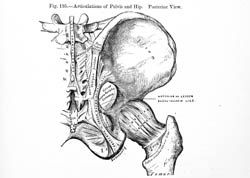Hip Endoprosthesis

Hip endoprosthesis surgery is a replacement of the dysfunctional joint with an artificial one. Often, the hip is damaged as the result of an illness or injury. In such cases, joint replacement is the best solution to restore its function.
This operation is widely used around the world, because it allows patients quickly to return to their normal life and to lead an active lifestyle without suffering from accompanying joint pain. The main indications for hip replacement are various traumatic lesions of the hip joint, rheumatoid arthritis and osteoarthritis, ankylosing spondylitis, infections or other types of lesions of femoral head etc.
Of course, the hip joint is one of the most important joints of the human locomotor system. It belongs to a group of joints of the globular type, bears a large load, and performs a significant amount of work, including flexion, extension and abduction, as well as inside and outside movements. The joint includes a femoral head and a ligament that connects it with the acetabulum.
From the standpoint of physics, the hip joint functions because the head of the femur is situated on the long bone that fits into the acetabulum, a socket located in a complex of pelvic bones. To ensure smooth movements, the acetabulum is filled with a special adipose tissue, and smooth motion of the femoral head in the cavity is ensured by the presence of a special soft cartilage that forms a kind of shell around the head. In addition, the whole structure of the joint is immersed in a fibrous capsule, stabilized by strong ligaments. Finally, the entire capsule is covered by another special envelope that includes an additional adipose pad. The lower area of the joint has a special slot through which an additional ligament and a collection of blood vessels, feeding the joint, enter. Within the hip joint there are a number of small, strengthening ligaments, which enable the normal functioning of the joint. In intact and healthy joints, all the surfaces (the cavity and the femoral head) are covered with a special soft cartilage that provides soft movements and acts as a shock absorber for all kinds of human movements in a vertical position.
One of the most common types of disease, which brings significant discomfort and pain in the hip joint, is the destruction or degradation of the joint cartilage: coxarthrosis or osteoarthritis. These diseases are considered to have a slow and chronic course, and they usually lead to a gradual degradation of the hip joint function, and possibly other joints.
Typically, the disease is characterized by periods of inflammation of different continuation, which are normally accompanied by moderate or severe pain in the joints. Patients usually seek medical attention during such periods of exacerbation. The main complaints are pain in the side or groin, in the front of the thighs or in the knee, pain in an upright or sitting position, walking and so on.
Diseases associated with impaired hip joints often occur by patients over 60-65 years. In addition to age-related changes and the overall aging of the body, causing problems with the hip joint, a variety of fractures, injuries, arthritis and circulatory disorders of the joint can also be responsible for the symptoms. To decide whether to conduct a hip endoprosthesis operation, your physician has to consider a wide range of factors, such as age and overall health condition, the frequency and severity of pain in the joints, physical changes in the structure of the joint, and so on.
In modern medicine, there are about 60 different types of prosthetic hip joint. Specialists have developed and used two approaches to this surgery:
- one-sided prosthesis, or the replacement only of the femoral head during surgery;
- complete prosthesis, which involves the replacement of the entire joint.
There are three distinct approaches to perform this operation according to the method of prosthesis fixation:
- cement fixation, where elements of the joint are secured by special bone cement;
- cementless fixation, in which the regeneration process of the bone tissue is stimulated in order to ensure fixation;
- combined fixation, where the joint is fixed using both cement and cement-free methods.
Artificial hip joints are made of special, high-strength materials that correspond to very high requirements of compatibility with the patient''s body and absence of hazaradous elements. In particular, the surfaces of artificial hip joints that move in the process of human activity are regularly subjected to friction. Thus, these once are made only from certain metal alloys, special polymers or ceramics.
It is acceptable for the friction surfaces that have contact with other surfaces to be metal-metal, metal-plastic, or ceramics-ceramics. According to physicians'' estimates, the best and most widely used joint replacement is a pair of "plastic-metal" pieces that can provide excellent and long-term joint function, even though it has a significant drawback — rapid erosion of the plastic. During physical activity, plastic particles fall into the joint tissue and lead to a significant loosening of the joint. This, in turn, creates the need for a repeated surgical intervention. In this context, a pair of "ceramic-ceramics" may seem preferable, but they are used much less frequently, since this material is characterized by its lower strength and difficulty in manufacturing. More often, the replacement joint will be metal to metal with low wear-and-tear and relatively high strength characterisitcs. A metal prosthesis may work without replacement about 20 years.
About 95% of these operations are successful, and the implanted hip joint functions normally during the whole period. As a rule, after a few months, the patient returns to his/her previous level of activity. In many cases, the full recovery is possible, and people can even do active sports. During the recovery period, however, it is very important to avoid lifting heavy loads, jumping or any sudden movements.
Artificial hips, of course, are subject to wear, so how long the prosthesis will last depends upon many factors: for example, the quality of the prosthesis, the quality of the operation for its installation, and how well the patient follows all the rules and guidelines during the rehabilitation period. It is believed that young people are more active than older patients, so young people often wear out a prosthesis sooner than old people.
According to the statistics, 95% of hip replacements serve around 15-20 years, before a significant loosening or mechanical destruction of the prosthesis. After that, the joint starts to hurt. In such cases, a second surgery, known as auditing, is performed. During auditing, the old prosthesis is removed and a new one is installed.



